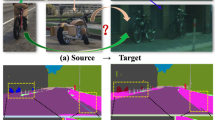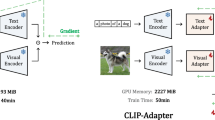Abstract
Few-shot learning is a critical task in computer vision processing that helps reduce deep learning’s reliance on large datasets. This paper aims to establish a few-shot learning network that is adaptive to diverse scenes. A novel approach referred to as task-adapted network with bi-directional long short-term memory network (BiLSTM-TANet) is proposed in this paper. BiLSTM-TANet is an end-to-end approach based on deep metric learning and designed to use the information from finite samples as much as possible. It fuses the context embeddings and structure information of the images and adaptively adjusts the features several times during the feature extraction of task to achieve task-specific embedding and quickly adapt to different distributed tasks, improves the feature extraction performance, and strikes a balance between model stability and generality. The model employs Euclidean distance as the classifier to reduce the number of model parameters and enhance the classification performance. Experiments conducted on miniImageNet, TieredImageNet, CUB200_2011 and CIFAR-FS datasets demonstrate the performance of the proposed BiLSTM-TANet. Furthermore, the effects of different few-shot learning parameters on the model’s performance are explored, providing a helpful reference for the future study of few-shot learning. Finally, a series of ablation studies are performed to analyze the performance of BiLSTM-TANet.













Similar content being viewed by others
Data Availability and Access
The datasets generated or analyzed during this study are available from the corresponding author on reasonable request.
Code Availability
The code is publicly available at https://github.com/Pixelsugar/BiLSTM-TANet.
References
Ma Y, Zhao S, Wang W et al (2022) Multimodality in meta-learning: A comprehensive survey. Knowl-Based Syst 250:108976
Guo R, Liu H, Xie G et al (2021) Weld defect detection from imbalanced radiographic images based on contrast enhancement conditional generative adversarial network and transfer learning. IEEE Sens J 21(9):10844–10853
Li X, Sun Z, Xue JH et al (2021) A concise review of recent few-shot meta-learning methods. Neurocomputing 456:463–468
Yang J, Guo X, Li Y et al (2022) A survey of few-shot learning in smart agriculture: developments, applications, and challenges. Plant Methods 18(1):1–12
Snell J, Swersky K, Zemel R (2017) Prototypical networks for few-shot learning. Adv Neural Inf Process Syst 30:4077–4087
Liu Y, Zhang H, Zhang W et al (2022) Few-shot image classification: Current status and research trends. Electronics 11(11):1752
Hospedales T, Antoniou A, Micaelli P et al (2021) Meta-learning in neural networks: A survey. IEEE Trans Pattern Anal Mach Intell 44(9):5149–5169
Zhang C, Li C, Cheng J (2019) Few-shot visual classification using image pairs with binary transformation. IEEE Trans Circuits Syst Video Technol 30(9):2867–2871
Ji Z, Hou Z, Liu X et al (2022) Information symmetry matters: a modal-alternating propagation network for few-shot learning. IEEE Trans Image Process 31:1520–1531
Vinyals O, Blundell C, Lillicrap T et al (2016) Matching networks for one shot learning. Adv Neural Inf Process Syst 29:3630–3638
Zhang J, Zhang X, Wang Z (2022) Task encoding with distribution calibration for few-shot learning. IEEE Trans Circuits Syst Video Technol 32(9):6240–6252
Xing L, Shao S, Liu W et al (2022) Learning task-specific discriminative embeddings for few-shot image classification. Neurocomputing 488:1–13
Li Y, Chen CP, Zhang T (2022) A survey on siamese network: Methodologies, applications, and opportunities. IEEE Transactions on artificial intelligence 3(6):994–1014
Huang G, Laradji I, Vazquez D et al (2022) A survey of self-supervised and few-shot object detection. IEEE Trans Pattern Anal Mach Intell 45(4):4071–4089
Ren Z, Zhu Y, Liu Z et al (2023) Few-shot gan: Improving the performance of intelligent fault diagnosis in severe data imbalance. IEEE Transactions on instrumentation and measurement
Goodfellow I, Pouget-Abadie J, Mirza M et al (2020) Generative adversarial networks. Commun ACM 63(11):139–144
Yang X, Yu Z, Jiang P et al (2022) Deblurring ghost imaging reconstruction based on underwater dataset generated by few-shot learning. Sensors 22(16):6161
Xu B, Zeng Z, Lian C et al (2022) Few-shot domain adaptation via mixup optimal transport. IEEE Trans Image Process 31:2518–2528
Feng R, Ji H, Zhu Z et al (2022) Selfnet: A semi-supervised local fisher discriminant network for few-shot learning. Neurocomputing 512:352–362
Song Y, Wang T, Cai P et al (2023) A comprehensive survey of few-shot learning: Evolution, applications, challenges, and opportunities. ACM Computing Surveys
Wang RQ, Zhang XY, Liu CL (2021) Meta-prototypical learning for domain-agnostic few-shot recognition. IEEE Transactions on neural networks and learning systems 33(11):6990–6996
Finn C, Abbeel P, Levine S (2017) Model-agnostic meta-learning for fast adaptation of deep networks. In: International conference on machine learning, PMLR, pp 1126–1135
Zhu X, Li S (2022) Mgml: Momentum group meta-learning for few-shot image classification. Neurocomputing 514:351–361
Fu Q, Wang Z, Fang N et al (2023) Maml2: meta reinforcement learning via meta-learning for task categories. Front Comp Sci 17(4):174325
Baik S, Oh J, Hong S et al (2021) Learning to forget for meta-learning via task-and-layer-wise attenuation. IEEE Trans Pattern Anal Mach Intell 44(11):7718–7730
Jiang W, Huang K, Geng J et al (2020) Multi-scale metric learning for few-shot learning. IEEE Trans Circuits Syst Video Technol 31(3):1091–1102
Tian R, Shi H (2023) Momentum memory contrastive learning for transfer-based few-shot classification. Appl Intell 53(1):864–878
Li X, Yang X, Ma Z et al (2023) Deep metric learning for few-shot image classification: A review of recent developments. Pattern Recognition p 109381
Sung F, Yang Y, Zhang L et al (2018) Learning to compare: Relation network for few-shot learning. In: Proceedings of the IEEE conference on computer vision and pattern recognition, pp 1199–1208
Guo R, Liu H, Xie G et al (2023) A self-interpretable soft sensor based on deep learning and multiple attention mechanism: From data selection to sensor modeling. IEEE Trans Industr Inf 19(5):6859–6871. https://doi.org/10.1109/TII.2022.3181692
Widhianingsih TDA, Kang DK (2022) Augmented domain agreement for adaptable meta-learner on few-shot classification. Appl Intell pp 1–17
Wang Z, Ma P, Chi Z et al (2022) Multi-attention mutual information distributed framework for few-shot learning. Expert Syst Appl 202:117062
Li Z, Hu Z, Luo W et al (2023) Sabernet: Self-attention based effective relation network for few-shot learning. Pattern Recogn 133:109024
Xu W, Xian Y, Wang J et al (2022a) Attribute prototype network for any-shot learning. Int J Comput Vis 130(7):1735–1753
Xu J, Liu B, Xiao Y (2022b) A multitask latent feature augmentation method for few-shot learning. IEEE Transactions on neural networks and learning systems
Cui Z, Lu N, Wang W et al (2022) Dual global-aware propagation for few-shot learning. Image Vis Comput 128:104574
Oreshkin B, Rodríguez López P, Lacoste A (2018) Tadam: Task dependent adaptive metric for improved few-shot learning. Adv Neural Inform Process Syst 31
Requeima J, Gordon J, Bronskill J et al (2019) Fast and flexible multi-task classification using conditional neural adaptive processes. Adv Neural Inform Process Syst 32
Perez E, Strub F, De Vries H et al (2018) Film: Visual reasoning with a general conditioning layer. In: Proceedings of the AAAI conference on artificial intelligence
Bateni P, Goyal R, Masrani V et al (2020) Improved few-shot visual classification. In: Proceedings of the IEEE/CVF conference on computer vision and pattern recognition, pp 14493–14502
Satorras VG, Estrach JB (2018) Few-shot learning with graph neural networks. In: International conference on learning representations
Li L, Jin W, Huang Y (2022) Few-shot contrastive learning for image classification and its application to insulator identification. Appl Intell 52(6):6148–6163
Li W, Wang L, Xu J et al (2019) Revisiting local descriptor based image-to-class measure for few-shot learning. In: Proceedings of the IEEE/CVF conference on computer vision and pattern recognition, pp 7260–7268
Liu X, Zhou F, Liu J et al (2020) Meta-learning based prototype-relation network for few-shot classification. Neurocomputing 383:224–234
Zhang Y, Wang C, Shi Q et al (2023) Adversarial gradient-based meta learning with metric-based test. Knowl-Based Syst 263:110312
Zhou F, Zhang L, Wei W (2022) Meta-generating deep attentive metric for few-shot classification. IEEE Trans Circuits Syst Video Technol 32(10):6863–6873
Huang H, Wu Z, Li W et al (2021) Local descriptor-based multi-prototype network for few-shot learning. Pattern Recogn 116:107935
Qin Y, Zhang W, Zhao C et al (2021) Prior-knowledge and attention based meta-learning for few-shot learning. Knowl-Based Syst 213:106609
Fu W, Zhou L, Chen J (2022) Bidirectional matching prototypical network for few-shot image classification. IEEE Signal Process Lett 29:982–986
Zhang J, Zhang X, Wang Z (2022) Task encoding with distribution calibration for few-shot learning. IEEE Trans Circuits Syst Video Technol 32(9):6240–6252
Zheng Z, Wu H, Lv L et al (2023) Iccl: Independent and correlative correspondence learning for few-shot image classification. Knowl-Based Syst 266:110412
Bi S, Wang Y, Li X et al (2022) Critical direction projection networks for few-shot learning. Appl Intell 52(5):5400–5413
Yan L, Li F, Zhang L et al (2023) Discriminant space metric network for few-shot image classification. Appl Intell pp 1–16
Asheghi R, Hosseini SA, Saneie M et al (2020) Updating the neural network sediment load models using different sensitivity analysis methods: a regional application. J Hydroinf 22(3):562–577
Abbaszadeh Shahri A, Shan C, Larsson S (2022) A novel approach to uncertainty quantification in groundwater table modeling by automated predictive deep learning. Nat Resour Res 31(3):1351–1373
Abbaszadeh Shahri A, Chunling S, Larsson S (2023) A hybrid ensemble-based automated deep learning approach to generate 3d geo-models and uncertainty analysis. Eng Comput pp 1–16
Acknowledgements
The authors wish to acknowledge Professor Qing Liu from Xi’an University of Technology for his help in writing the paper.
Funding
This work was supported in part by Major Research Program of National Natural Science Foundation of China under Grants 92270117, Major Instrument Project of National Natural Science Foundation of China under Grants 62127809, The 2023 General Special Scientific Research Program of the Department of Education of Shaanxi Province under Grants 23JK0387, The Doctoral Scientific Research Startup Foundation of Xi’an University of Technology under Grants 103-451123015.
Author information
Authors and Affiliations
Contributions
Experiment, Writing-review editing: He Zhang; Reviewing, Supervision: Han Liu; Reviewing, Proof reading: Lili Liang; Reviewing: Wenlu Ma; Reviewing, Proof reading: Ding Liu.
Corresponding author
Ethics declarations
Ethical and Informed Consent for Data Used
All authors disclosed no relevant relationships.
Competing Interest
The authors declare that they have no competing interests.
Additional information
Publisher's Note
Springer Nature remains neutral with regard to jurisdictional claims in published maps and institutional affiliations.
Rights and permissions
Springer Nature or its licensor (e.g. a society or other partner) holds exclusive rights to this article under a publishing agreement with the author(s) or other rightsholder(s); author self-archiving of the accepted manuscript version of this article is solely governed by the terms of such publishing agreement and applicable law.
About this article
Cite this article
Zhang, H., Liu, H., Liang, L. et al. BiLSTM-TANet: an adaptive diverse scenes model with context embeddings for few-shot learning. Appl Intell 54, 5097–5116 (2024). https://doi.org/10.1007/s10489-024-05440-y
Accepted:
Published:
Issue Date:
DOI: https://doi.org/10.1007/s10489-024-05440-y




